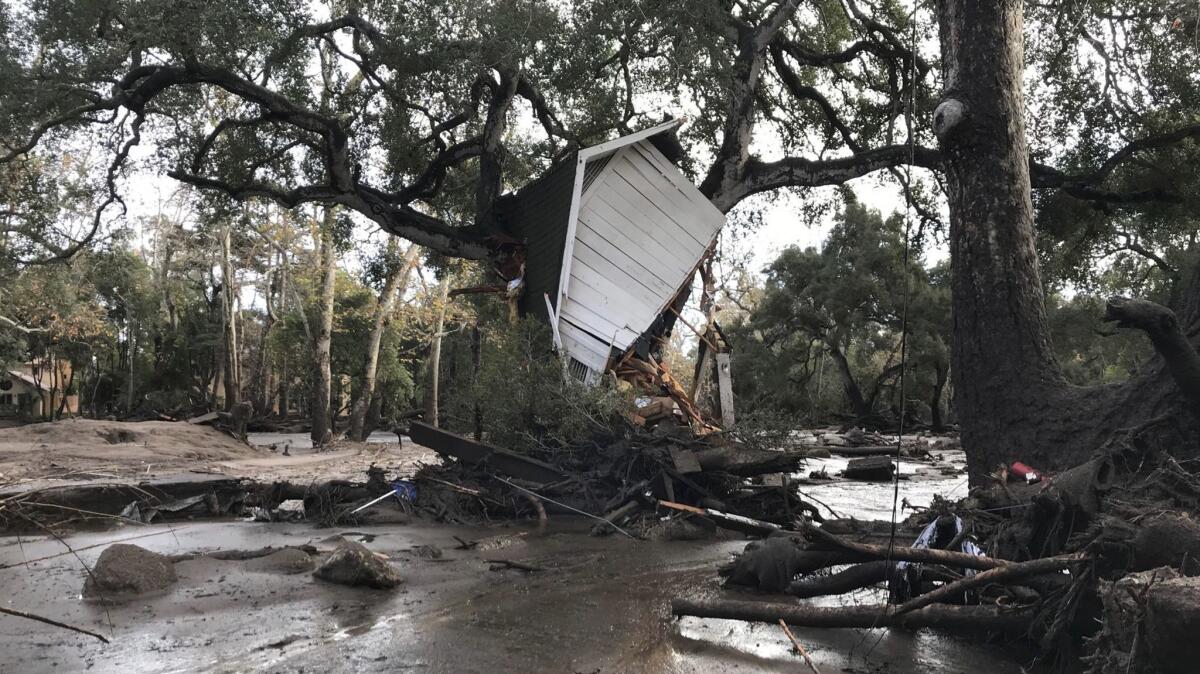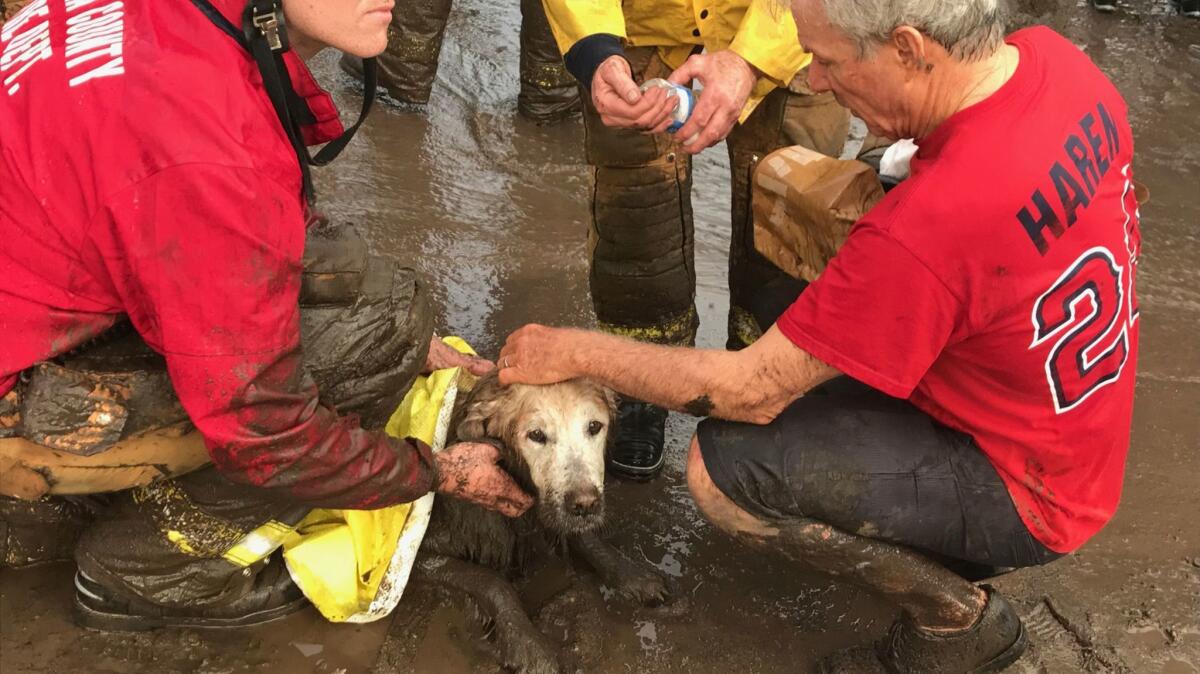Scene of devastation in Montecito as mud buries whole neighborhoods

Devastation from mudflows in Montecito has sparked debate about what could be done to get more people out of harm’s way.
- Share via
Reporting from Montecito, Calif. — At East Valley Road, a deafening growl in the dark announced to all who stayed that they made the wrong call. A three-story wall of mud, rock and timber tore down Montecito Creek faster than any human could run.
The torrent early Tuesday stripped the back of a house that sat 20 feet above the creekbed. Mud blasted through the back of a neighbor’s garage and lifted a Porsche, launching it through the garage door.
The flood of debris grew as it moved, taking down hedges, trees, concrete walls and half-ton rocks, devouring house after house, their rafters and floor joists becoming the leading edge to destroy the next. Cars crumpled. Telephone poles snapped.
“Oh my God,” Mark Burnett, a Montecito resident surveying the damage on his way to retrieve his dog, said Wednesday. “There were houses all through here.”
All that was left on this stretch of East Valley was a displaced but intact garage, stuck high in an oak tree. The canyon floor was a slick of deep mud, thick with gravel, a concrete-like slurry impossible to walk in.

At the edges of the flood, standing homes were half filled with muck, windows smashed, doors blown open. The mud line on some was near the eaves.
Firefighters walked the area calling out, listening for voices, shaking their heads in awe.
The force of a debris flow like this is almost impossible to imagine. What could move a sandstone boulder the size of a pickup truck hundreds of yards? Where did the missing houses go? How far had that mangled Hummer on the beach traveled?
The last year in California, nature has showed its power on many fronts.
No one knows exactly when a debris flow, fire’s aftermath, will let loose. But when it does, there is no escape.
So far 17 bodies have been recovered from the overblown creeks in Montecito, and officials are still searching for more.
::
A fiendish trait of mudflows is that by following the lowest course, they hit houses the fire spared. And they run far deeper into the urban zone — in this case right to the Pacific.
Curt Pickering, 60, lost his house just up the hill from Montecito Creek in the fire. He moved into another house on the same property.
“We were just recovering,” he said. “We just finished cleaning up the ash from the fire.”
On Wednesday, Pickering, a scout for the Indiana Pacers, walked down the road to check on a friend, Terrance Ladd, who lived along the normally dusty streambed. Their sons grew up together.
He stopped at a modern glass house filled with a foot of mud. The steel gate was blown open, a concrete wall toppled. A diesel truck that had been parked on the street was twisted against a tree 50 yards away.
“This is the area the fire spared,” he said. “There’s the irony.”
He had planned to cross Montecito Creek on a little rock bridge, but that had vanished; the mud was too thick to continue anyway. He feared the worst about his friend. Even though they lived in a mandatory evacuation zone, many residents did not leave. “No one imagined what these boulders and logs would do.”
Above, the steep front of the Santa Ynez Mountains was black from December’s massive Thomas fire, with rain ruts running down into the canyons.
The fire had denuded the slopes and left a layer of oil on the ground that made it difficult to absorb the rain.
Water that fell on 6.2 square miles of rugged high terrain funneled into this tiny creek. Nothing was going to stop the cataclysm.
“This just kind of makes a farce out of the structures man builds,” Pickering said.
Just to the south lay a waste of mud that only the thickest oaks withstood. Meadow Wood Lane disappeared into it. An alarm blared through the otherwise dead silence. No tire tracks, no foot prints crossed the deep mud to flooded homes. No one answered to calls, “Is anybody here?”
From here, the flow had kept racing down the creek, roaring over East Valley Road, then jumping out of the channel onto a new course, mowing down house after house and spilling into side streets. Finally it found a straight slot down Olive Mill Road to the ocean.

Dana Fisher lives a block off Olive Mill in what was a voluntary evacuation zone, just 92 feet above sea level, miles from the fire zone, miles from what he thought vulnerable to natural disaster. He woke up to alerts at 3:20 a.m. Monday and peered out to see a stream of clear water in his street, about a foot wide and an inch deep. He went to get some plywood to keep it out of the yard when he heard a horrible sound up Olive Mill.
“The logs and the boulders, it was just this roar.”
He lived through the debris flows of 1969 and knew the danger. He ran inside. Soon he saw the flow gushing through his backyard.
He made the mistake of opening the front door to assess the situation, and mud pushed in. He tried to slam it shut, but gravel made it impossible. He and his wife put chairs against the door and sat in them until daybreak to keep more mud from pouring into the house. Still, it oozed its way through the crack, covering the kitchen and family room floor. Outside, it carried their Jetta about eight feet and their Jeep to a neighbor’s house.
They eventually wedged a couch to keep the door from opening further. As debris piled up at the entrance, it created its own dam and the flow stopped.
Olive Mill Road itself had become a flume. The debris flow crossed over the 101 Freeway overpass, ripping out the north side guardrail, pouring onto the lanes below, and creating a quarter-mile lake. The rest bored dead-ahead to the beach.

Residents, many elderly, at the seaside Bonnymede and Montecito Shores condo complexes found themselves cut off by the mud. Some were waiting for low tide to walk to Channel Drive and get to Vons to buy food.
The sun was shining, brown waves giving way to the blue beyond.
Where Montecito Creek let out, two mangled cars lay on the sand. People sifted through the jetsam along the beach — basketballs, broken surfboards, gas cans, lawn chairs.
Dana McCorkle, 51, likened the disaster to the debris flows of January 1969. But those came after weeks of rain, not one night. The retired firefighter figures this could get a lot worse in the end.
“This is a big scale for just one storm,” he said.
Up the road, Fisher spent the day of the flood shoveling out his house. When he and his wife started to leave before nightfall, their 14-year-old dog Maverick got stuck in the mud. Fisher tried to lure him along with biscuits, but the dog started shivering and froze in place. Fisher dragged Maverick to the street and firefighters drove them to safety.
“We got to grandma’s house and we both got in the tub,” he said. “It took us two tubs to get fairly clean.”
More to Read
Sign up for Essential California
The most important California stories and recommendations in your inbox every morning.
You may occasionally receive promotional content from the Los Angeles Times.














